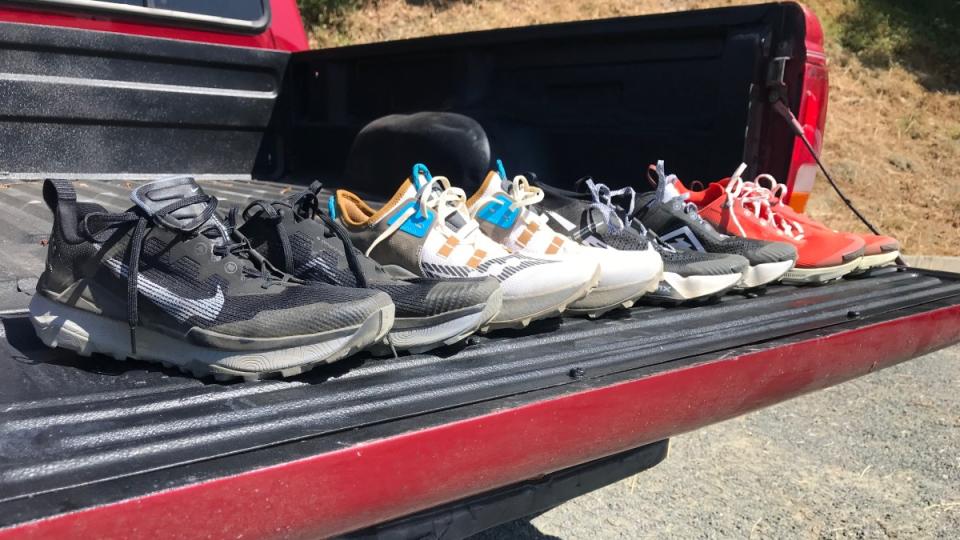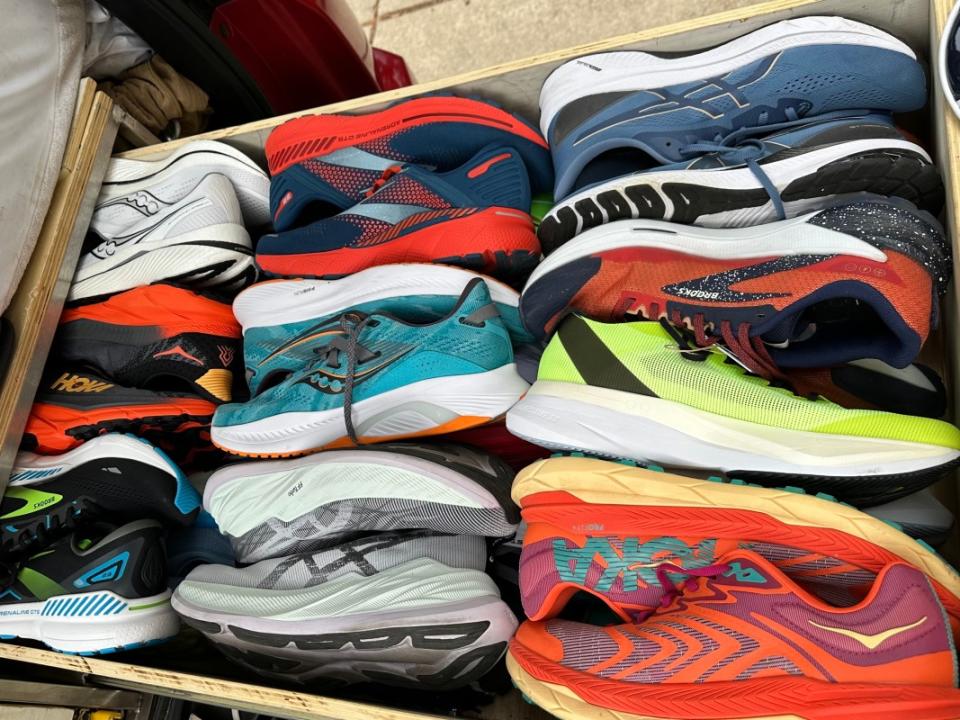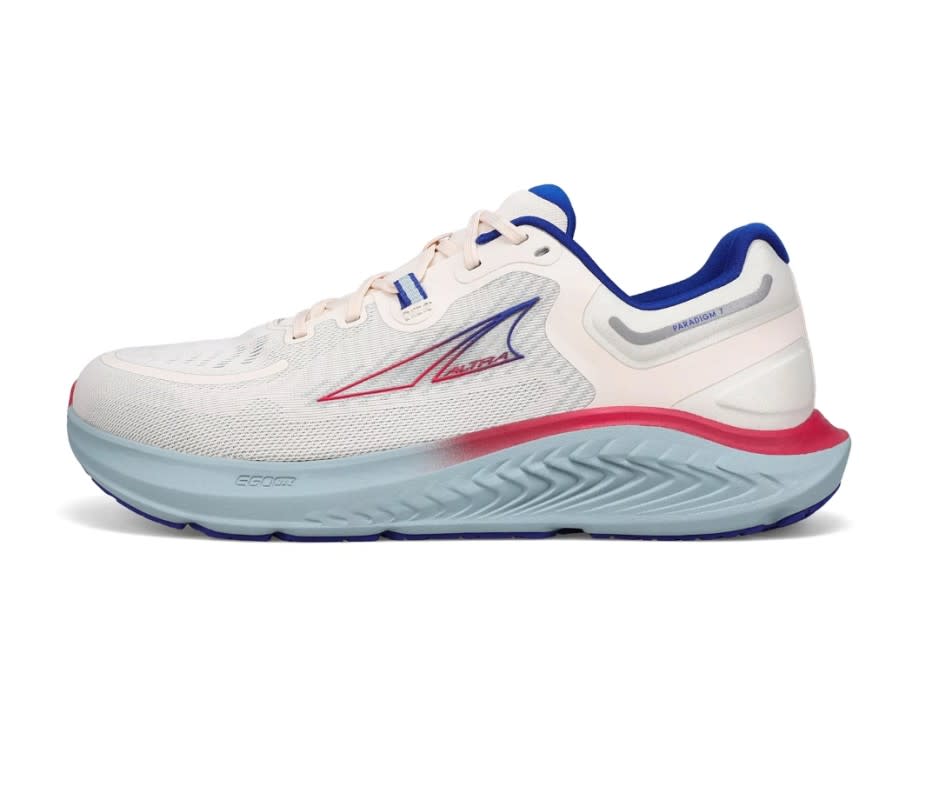The Best Running Shoes of 2024: We Tested Dozens of Pairs to Find Our Favorites
For the average runner, choosing the best running shoes is a daunting task. There’s an overwhelming number of options on the market, and even for experienced athletes, it can be difficult to know which shoe models will best suit your running style, gait, and the terrain you run on.
To help you sort through the footwear deluge, the Men’s Journal staff and I put dozens of running shoes to the test and highlighted our favorites in this guide.
Men’s Journal aims to feature only the best products and services. We update when possible, but deals expire and prices can change. If you buy something via one of our links, we may earn a commission.
Best Overall Men's Running Shoe: Saucony Endorphin Speed 4
It's always nerve-racking when a company announces it's overhauling a beloved shoe—especially when it's a shoe we like as much as the Saucony Endorphin Speed 3. But before you go buying up the reserve stock, Saucony got this update right. The Saucony Endorphin Speed 4 is just as poppy, comfy, and versatile as ever, making it a great choice for nearly every runner.
Related: We Tested a Dozen Saucony Running Shoes. These Are Our Favorites
The big change in the new version is the upper, which is made of a very breathable mesh that's comfy and fits well, if just a tad narrower in the toes than the last edition. Saucony also tweaked the midsole formula, adding a nylon plate and new outsole rubber. All this is to say that the Endorphin Speed 4 definitely feels different from its predecessor—nimbler, more responsive—but it still excels in all the same areas. The main area is versatility. While the Endorphin Speed is fun to run fast in, rebounding excellently during interval workouts, it also handles slow paces and long distances thanks to its comfy foam platform. And at $170, it's priced like an everyday running shoe, even though it's racing shoe-inspired.
However, runners who need stability features won't find them here. And, as in the previous model, there's still a lot of exposed midsole foam on the bottom of the shoe that wears over time. Even so, we expect to take this shoe well beyond 250 miles.
Weight: 8.1 oz
Drop: 8 mm
Pros | Cons |
|---|---|
Lightweight and breathable | Mesh tongue bunches up sometimes |
Responsive and fast | Not ideal for stability runners |
Versatile enough for training and racing |
Best Men's Trail Running Shoes: Nike Pegasus Trail 4 GTX
The Nike Pegasus Trail 4 GTX earned its status as our favorite trail shoe because it tackles a variety of terrains really well. Men’s Journal editor Michael Charboneau tested this shoe, and he loved the React midsole foam: It hit a perfect balance of shock absorption and bouncy responsiveness. In both wet and dry conditions, the shoe created confidence-inspiring grip on hard-packed trails, rock, and even pavement.
Related: The Best Nike Running Shoes of 2024
The Gore-Tex liner kept his feet warm and dry through light rain, and the flexible upper created a close fit without slippage. If you run on primarily dry trails or in hot weather, however, these aren’t the best pick—the Gore-Tex upper reduces the shoe’s breathability. Check out our trail running shoes guide for even more options.
Weight: 10.2 oz
Drop: 9.5mm
Pros | Cons |
|---|---|
Good traction on varied terrain | Upper lacks breathability |
Great for wet weather | |
Well-balanced cushioning |
Best Men's Running Shoes for Flat Feet: Altra Paradigm 7
Altra Paradigm 7 is a well-cushioned shoe with a spacious footbed and built-in support, and it’s a strong choice for those with flat feet or collapsed arches. It utilizes Altra’s signature Balanced Cushioning design: The heel and forefoot are at the same height within the shoe, otherwise known as zero drop. When running, zero-drop shoes shift the load away from your knees to your ankles and calf muscles, so these designs can benefit flat-footed runners who suffer from knee pain. The flat footbed is a matter of preference—you’ll have to try these on to see if they work for you—but the Paradigm has other features that work well for flat feet, too.
Anyone familiar with Altras has probably noticed the shoes have a “weird looking toe box,” as one tester put it. The Paradigm looks a little squared off and boxy at the front, but testers found it fit much better than expected, with no looseness, and it gave their toes plenty of room to splay. In addition to a spacious toe box, the shoe has a generous midfoot area that won’t constrict flat feet, and it’s available in wide sizes for even more room. The Paradigm has a relatively thick layer of midsole cushioning for a comfortable ride, and it’s also built with Altra’s GuideRail, a layer of foam on the medial side of the shoe that supports the foot and keeps it properly aligned within the shoe.
If you haven’t tried zero-drop shoes before, stick to short runs at first and give your body time to adjust. And even if you don’t have flat feet, these shoes can be beneficial: I’ve noticed Altras can ease hot spots on my feet that develop after wearing higher-drop shoes.
Weight: 10.4 oz
Drop: 0mm
Pros | Cons |
|---|---|
Excellent fit for flat feet (and wider feet) | Zero-drop design can feel uncomfortable to some |
Stable, well-cushioned ride |
Best Men's Running Shoes for Wide Feet: Brooks Adrenaline GTS 23
The Adrenaline is a standout model for wide-footed runners in search of a proper fit. To test this shoe, I worked with my uncle and cousin, both of whom have boxy, wide feet. My cousin recently converted to the Brooks Adrenaline GTS 22. My uncle tried the updated 23.
Often, folks with wide feet must settle for one of two extremes: either wearing shoes that are too narrow and constrict their feet, or wearing shoes that are the correct width but don’t keep their feet secure within the shoe. The Adrenaline solves both issues. The shoe is available in wide (2E) and extra-wide (4E) sizes, so you can get plenty of space no matter the shape of your foot. It’s also equipped with Brooks’ GuideRails, which are firmer layers of foam placed around the heel and the medial side of the footbed. The GuideRails cradle your feet, countering overpronation and keeping them aligned in the shoe—even if you opt for the extra-wide sizes.
Related: We Tested 16 of the Newest Brooks Running Shoes. These Are the Best
Testers loved the shoe’s wide toe box and very stable feel; they also appreciated its flexibility and secure fit. My uncle was shocked to discover he could fit into the Adrenaline without using specialized lacing techniques—something he often has to do with other shoes. The Adrenaline has the same soft cushioning as the Ghost below, and it’s a great everyday trainer for wide-footed runners.
Weight: 10.1 oz
Drop: 12mm
Pros | Cons |
|---|---|
Available in wide and extra-wide sizes | High drop may be uncomfortable for some runners |
Very stable ride |
Best Men's Stability Running Shoes: Hoka Gaviota 4
While I can definitely get away with neutral shoes, a stability shoe designed to correct overpronation helps my stride, especially during everyday runs and longer efforts. While Hoka pushes the Arahi as its primary stability shoe, I found the Gaviota 4 to be my favorite stability-focused option from any brand.
Related: We Tested Every Hoka Running Shoe—These Are the Best
The Gaviota 4 has a midsole setup similar to the Bondi, Hoka’s popular max-cushion model. This means the Gaviota has lots of plush cushioning (and a correspondingly high weight). Unlike the Bondi, the Gaviota includes Hoka’s J-Frame—essentially, a layer of firmer foam within the midsole that cradles the heel and supports the medial side of the foot. In my testing, I liked the Gaviota’s wide sole geometry, which created a planted feel despite the shoe’s tall stack, and the J-Frame effectively prevented my feet from rolling too far inward. In addition, the rocker sole shape made transitions smooth and easy. While it’s definitely a heavy shoe, the Gaviota excels at longer, slower recovery runs, and it’s a strong choice for overpronators.
Weight: 11.4 oz
Drop: 5mm
Pros | Cons |
|---|---|
Very stable ride | Heavy |
Comfortable feel |
More Great Running Shoes We Love
Related: We Tested 16 New Balance Running Shoes. These Are the Best
The Best Shoes From Top Running Brands
If you're loyal to a certain brand, whether it be for fit, performance, or history, we also have our top shoe picks for every type of run from the biggest running shoe brands.
How We Tested and Selected the Best Running Shoes of 2024
I worked with Men’s Journal editors and a team of wear testers—ranging from dedicated marathoner racers to fitness runners—to try as many top running shoes as possible. We called in test pairs and organized the shoes into 12 categories representing various running disciplines and runner preferences, including racing shoes, trail shoes, and shoes for wide feet. We ran in each shoe and evaluated it for key traits like fit and comfort, midsole cushioning, weight, and overall value. We took notes on our testing experiences and used those impressions to choose the shoes that made it into this guide.

Michael Charboneau
What to Consider When Shopping for Running Shoes
There are a few key factors to keep in mind when searching for and comparing running shoes.
Fit and Comfort
Fit and comfort are arguably the most important factors in any running shoe, and they’re also the hardest to assess when shopping online. Dr. Paul Nasri, a New York-based physical therapist with years of experience working with runners, recommends shopping the old fashioned way: Going to a running store. There, you can get your feet sized and try out shoes to determine what pair feels right for you.
“You should walk and run on the treadmill to make sure you feel comfortable in that sneaker,” Nasri tells Men’s Journal.

Nathan Lemin
How You Run
In addition to choosing a shoe that feels comfortable, make sure it’s designed for the kind of running you like to do.
Speed Training and Racing: Runners who are focused on speed will benefit from lightweight, responsive shoes that feel bouncy and propulsive underfoot. The Adidas Adizero Boston 12 is a great example of this kind of shoe: It features a midsole design that’s optimized for a snappy feel with lots of energy return, which helps you maintain faster paces.
Everyday Running: For day-to-day training, look for shoes that are durable, cushioned, and supportive. Because you’ll put a lot of miles on these pairs, focus on options with rubber outsoles that cover most of the bottom of the shoe—they’ll last longer and provide better traction, too. While the exact amount of midsole cushioning is a matter of personal preference, most runners prefer a well-cushioned shoe for their everyday trainer, as it absorbs impact forces and feels comfortable.
Support features can also be helpful in a daily trainer, especially for runners who overpronate (their feet roll inward between landing and toe-off). Although Nasri cautions that some inward rolling, or pronation, is a normal part of running, many runners appreciate shoes that counteract this motion. The Asics GT-1000 and Hoka Gaviota 4 below both have midsoles with firmer foam layers designed for support: They cradle the feet and bolster your arches to keep your feet aligned in the shoe as you run.
Related: We Tested Every Running Shoe Asics Offers. These Are the Best
Long-Distance Running: Everyday training shoes can work fine for longer runs, but you can also consider shoes with even more cushioning and support—they’ll create a soft, comfortable ride and promote good form, even when your legs get tired. The Asics NovaBlast 3 is our pick for a max-cushion shoe, and it’s ideal for long runs: Although it lacks support features, it provides excellent shock absorption and a responsive ride to keep you going through high-mileage efforts.
Trail Running: Do you mainly run on trails? You’ll need trail shoes. These models are designed for off-pavement running, and they feature durable rubber outsoles with lugs (small, cleat-like protrusions) that dig into soft ground and generate traction in the dirt. The Nike Pegasus Trail 4 GTX, our pick for the best trail shoe, offers a grippy lugged outsole and a cushioned-yet-responsive ride, and it also has a water-resistant upper to keep your feet dry in wet weather. For even more off-road options, browse the Men’s Journal trail shoes guide.
Related: We Tested Dozens of On Running Shoes. These Are the Best
Key Specs
Weight and Drop
We’ve included the weight and drop measurements for each shoe in this guide. Drop refers to the difference in height between the heel and the forefoot along the footbed of the shoe—the higher the drop, the steeper the slope from heel to toe within the shoe. The amount of drop affects how the forces of running are dispersed across your legs: High-drop shoes (8mm or more) put more load on your knees, while low-drop shoes (4mm or less) shift the load to your ankles and calves.
Lighter shoes are generally better suited to speedwork and faster paces, and heavier shoes usually offer more cushioning, durability, and support. There’s no right or wrong amount of drop; it’s purely a matter of what feels comfortable on your feet. These specs can help you compare models, but the most important thing is to choose a shoe that suits your needs and running style.






















